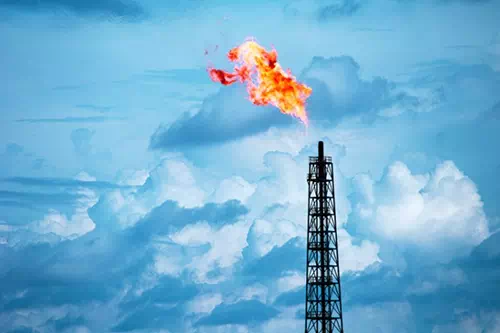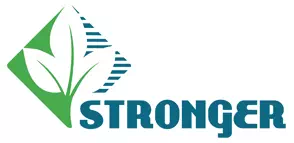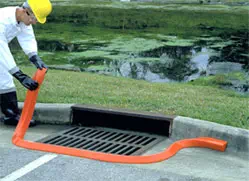

|
Oil Pollution Regulation
Spill Prevention, Control, and Countermeasure (SPCC) Rule and the Facility Response Plan (FRP) Rule The Spill Prevention, Control, and Countermeasure (SPCC) rule (issued under CWA Section 311 and published at 40 CFR part 112) includes requirements to prevent oil discharges to navigable waters or adjoining shorelines. In 1990, the Oil Pollution Act amended the Clean Water Act, resulting in new regulatory requirements in 40 CFR part 112 requiring certain high risk oil storage facilities to develop Facility Response Plans (FRPs). These plans require facilities to prepare, submit and respond to oil discharges to navigable waters or adjoining shorelines. The following topics are discussed below: Prevention - SPCC Requirements SPCC requirements typically do not apply to the dry gas production operations. However, if a natural gas production operation stores sufficient liquid oil condensate to exceed the regulatory thresholds, then it may be subject to SPCC. For example, wet gas production facilities may generate liquid oil condensate through the separation process at the tank battery and if the storage capacity of the container exceeds the regulatory threshold, then the facility may be subject to the SPCC rule. Additionally, the processing of natural gas at a gas processing plant, in an effort to remove impurities, may also result in the generation and storage of liquid oil condensate in quantities that exceed the regulatory threshold and thus these non-production processing operations may be regulated by the SPCC rule. For more information on the applicability of the SPCC rule and gas processing plants see the EPA letter to API on the issue. Finally, the SPCC rule will typically apply to gas drilling and workover activities when the drill rig's oil storage capacity and other petroleum oil storage on a pad site exceeds the applicability threshold. A key element of the SPCC rule requires facilities to develop, maintain and implement an oil spill prevention plan, called an SPCC Plan. These plans help facilities prevent oil spills, as well as control a spill should one occur. A natural gas production, drilling, workover or gas processing plant is subject to SPCC requirements if the facility:
Prevention - SPCC Plan Requirements All facilities subject to SPCC requirements must prepare a site-specific spill prevention plan that incorporates the general requirements for all facilities found in 40 CFR Part 112.7. Then you must also comply with the applicable facility specific requirements located in 40 CFR part 112.8, 112.9 112.10 or 112.11 (depending on facility type/location). For drilling workover and production facilities, these include considerations for the following processes and procedures:
In addition, the plan must discuss spill history and spill prediction (i.e., the anticipated direction of flow). The SPCC Plan must be approved by a registered Professional Engineer (PE) who is familiar with SPCC requirements, be fully implemented, and be modified when changes are made to the facility that may materially affect the potential for an oil discharge (e.g., installation of a new tank). EPA has recently revised the SPCC rule to allow the owner or operator of a facility that meets certain eligibility criteria to certify their SPCC Plan without a PE. A certain portion of the natural gas operations may qualify for these streamlined regulatory options (see below). Regardless of whether changes have been made to the facility, the plan must be reviewed at least once every five years, and amended if new, field-proven technology may reduce the likelihood of a spill. The SPCC must be available onsite for review by EPA or other inspectors.
The SPCC rule has streamlined requirements for facilities with smaller oil storage capacity that have not had oil discharges (spills). The owner or operator of a "qualified facility" can prepare and self-certify an SPCC Plan rather than have a PE review and certify the Plan. There are tiers for qualified facilities, Tier I and II. To determine if you have a qualified facility you need to know the total capacity of aboveground oil storage containers at the facility and information on oil discharges from the facility for the past three years.
Please note: This does not include discharges that are the result of natural disasters, acts of war, or terrorism. When determining the applicability of this SPCC reporting requirement, the gallon amount(s) specified (either 1,000 or 42) refers to the amount of oil that actually reaches navigable waters or adjoining shorelines not the total amount of oil spilled. EPA considers the entire volume of the discharge to be oil for the purposes of these reporting requirements. A Tier II qualified facility must prepare and implement an SPCC Plan that follows all of the rule requirements in 40 CFR 112; however, the owner or operator can self-certify the facility SPCC Plan and future amendments to the Plan instead of having the SPCC Plan reviewed and certified by a PE. A Tier I qualified facility can complete and self-certify the SPCC Plan template found in Appendix G of 40 CFR part 112. The Plan template is a simple SPCC Plan that includes only the requirements that apply to this tier of regulated facilities. The Plan template is available, in several formats. The completed and certified template serves as the SPCC Plan for the facility. A Tier I qualified facility can certify any future amendments to the SPCC Plan. Which SPCC rules typically apply to the natural gas industry? The following is a summary of SPCC regulations that typically apply to the land-based natural gas extraction and production sector:
Preparedness - Facility Response Planning SPCC-regulated facilities may also be subject to Facility Response Plan (FRP) requirements if they could reasonably be expected to cause "substantial harm" to the environment by discharging oil into or on navigable waters or adjoining shorelines. The determination of a "substantial harm" facility is made on the basis of meeting of the following criteria:
The Oil Pollution Prevention regulation (40 CFR 112.20) provides detailed information on these criteria. The rule includes two methods by which a facility may be identified as posing substantial harm:
The EPA Regional Administrator may consider factors similar to the self-selection criteria, as well as other factors, including:
In addition, the EPA Regional Administrator may determine that a facility poses significant and substantial harm. Facilities that pose significant and substantial harm must have their plans reviewed and approved by EPA. If the facility is found to be subject to FRP requirements, either through a self-assessment or by EPA Regional Administrator determination, the facility would be required to develop an FRP which would include, among other requirements:
FRPs must be submitted to EPA for review and be periodically updated. Response - What if there is an oil discharge (spill)? Should a spill occur despite precautions, established responses should be undertaken. If the facility is subject to the Oil Pollution Prevention regulation, the facility will be equipped with secondary containment and diversionary structures to prevent the spill from reaching drains, ditches, rivers, and navigable waters. These structures may be berms, retention ponds, absorbent material, weirs, booms, or other barriers or equivalent preventive systems. Should these secondary containment devices not be adequate, the response should be to stop the flow of oil, recover as much oil as possible of, then minimize the impacts on navigable waterways, adjoining shorelines or groundwater. Reporting oil spills Any person in charge of a vessel or an onshore or offshore facility must immediately report discharges to the National Response Center (NRC) at 1-800-424-8802 or 1-202-426-2675. The NRC is the federal government's centralized reporting center, which is staffed 24 hours per day by U.S. Coast Guard personnel. If reporting directly to NRC is not practicable, reports also can be made to the EPA regional office or the U.S. Coast Guard Marine Safety Office (MSO) in the area where the incident occurred. NRC personnel will ask a caller to provide as much information about the incident as possible including:
Additionally, if a facility is regulated under the SPCC rule the facility owner or operator may also be required to submit a report to the EPA Regional Administrator when oil is discharged to navigable waters or adjoining shorelines as follows:
Finally, there may be other Federal, State and Local oil spill reporting requirements depending on facility locations. Implementation of CWA Section 311 cannot be delegated to states or tribes. However, states or tribes may implement their own oil spill prevention and spill notification requirements that may be consistent or more stringent to the SPCC rule. Please check with your state or tribal government to see if they have any state- or tribe-only requirements related to prevention and control of oil and associated reporting of discharges/spills.
Additional SPCC Rule Reference Material (EPA). Reference material provided on this web page may help facilities better understand SPCC requirements and EPA's positions on the implementation of the SPCC rule. Facility Response Planning (EPA, Aug. 2002). This guide is part of a series of compliance assistance guides that the U.S. Environmental Protection Agency (EPA) developed in order to help owners and operators of facilities that store or use oil, as well as other interested people, to better understand the Federal Oil Pollution Prevention regulation. Oil Pollution Prevention Regulation Overview (EPA). The Oil Pollution Prevention regulation sets forth requirements for prevention of, preparedness for, and response to oil discharges at specific non-transportation-related facilities. SPCC for the Upstream Sector - Production, Drilling, and Workover (EPA). Various EPA resources, including a SPCC template. Spill Prevention, Control, and Countermeasure (SPCC) Rule (EPA). The SPCC rule includes requirements for oil spill prevention, preparedness, and response to prevent oil discharges to navigable waters and adjoining shorelines. SPCC Guidance for Regional Inspectors (https://www.epa.gov/oil-spills-prevention-and-preparedness-regulations/spcc-guidance-regional-inspectors ) In August 2013, EPA revised the SPCC Guidance for Regional Inspectors. This guidance is intended to assist regional inspectors in reviewing a facility's implementation of the Spill Prevention, Control, and Countermeasure (SPCC) rule at 40 CFR part 112 (PDF) (117 pp, 4.3 MB, About PDF). This document is also available to owners and operators of facilities that may be subject to the requirements of the SPCC rule and the general public. The document is designed to provide a consistent national policy on several SPCC-related issues.
|
|||||||||||||||
Funded by EPA through a Cooperative Agreement
|
 |
||
About | Technical Topics | Federal Statutes & Regulations - US EPA | Federal Statutes & Regulations - Non-EPA | Emergency Response |
|
EPA Resources | State/Local Resources | Other Resources | Acronyms | Search | Disclaimer | Home




